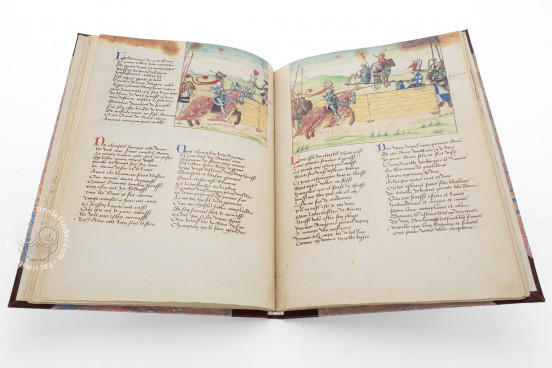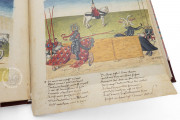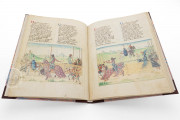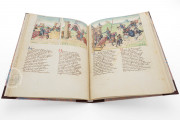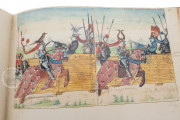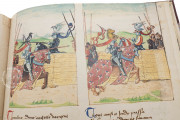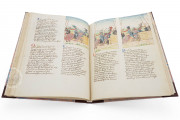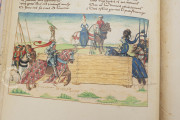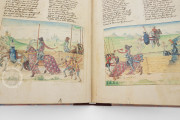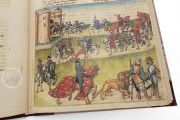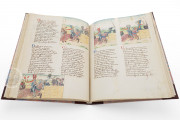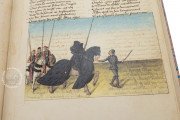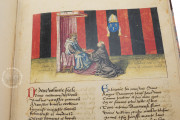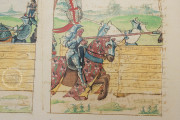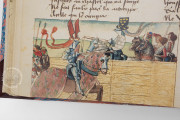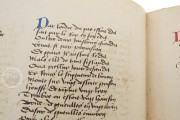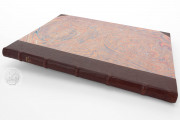Produced in France in the 1470s, the Tournament at Saumur manuscript records the events of the Pas de Saumur, a festival with a series of costumed jousts sponsored by René I, Duke of Anjou, and King of Naples and Jerusalem. It is the only surviving version of the Relation du Pas de Saumur, a verse chronicle written by an anonymous cleric who attended the event. The text is enriched with ninety miniatures of the pas, in which many characters can be identified. The manuscript provides valuable insight into the tournament's organization and its expression of chivalric ideals.
The Tournament at Saumur represents one of the most significant manuscripts preserved in the Russian National Library in Saint Petersburg. As the sole historical record of this prestigious event, the manuscript offers invaluable insights into late medieval chivalric culture and tournament practices.
Artistic Merit and Illustration
The codex features 90 illustrations of remarkable historical significance, distinguished by their dynamic composition and meticulous attention to detail. These masterfully executed pictures derive from the lost original drawings of Barthélemy d'Eyck, an accomplished artist who served at René's court for an extended period. The illustrations, executed in pen and watercolor, complement the text with visual representations of the tournament proceedings.
Variations in coloration, landscape depiction, and the representation of knights and their helmets suggest multiple artists contributed to the manuscript's creation. The illustrated cycle functions as a crucial visual counterpart to the text, with both elements contributing equally to the work's historical value.
Literary and Historical Significance
The manuscript's significance extends beyond its artistic merits to encompass its value as a historical and literary document of the fifteenth century. Scholars specializing in medieval history, literature, and culture have been drawn to this rare text, which also provides abundant material for heraldic studies through its detailed depictions of coats of arms and crests. The manuscript enables a comprehensive reconstruction of the tournament proceedings, making it an informative document on the evolution of knightly mock battles in the late Middle Ages.
Tournament Description and Chivalric Culture
The anonymous poet provides detailed accounts of the tournament's organization and ceremonial aspects, focusing particularly on the joust—a formalized combat between two knights. The narrative describes the participants, their equipment (especially bascinets), and the decorative harnesses and mantling adorning the warhorses. Beyond mere description, the poet contextualizes tournaments within their broader significance to courtly and chivalric culture. The text reveals how ritualized combat allowed knights to demonstrate their fundamental values: courage, generosity, honor, glory, fealty, and courtly love.
René d'Anjou: Royal Patron and Poet
René d'Anjou, King of Naples and Sicily, Duke of Anjou, Bar, and Lorraine, emerges as a central figure in this manuscript. Beyond his political ambitions, René distinguished himself as an educated patron of the arts and an accomplished poet, authoring works such as Livre du Cuer d'Amours Espris, a romantic allegory demonstrating his literary talent. His tournaments gained national renown and inspired numerous poets. As both organizer and likely commissioner of the manuscript, René's influence permeates the work.
Poetic Craftsmanship and Heraldic Focus
The manuscript's 3,952 verses reveal exceptional poetic craftsmanship, with the anonymous author maintaining strict adherence to verse structure and rhythm throughout. The poet focuses predominantly on combat scenes, with particular attention to heraldic devices, shields, horse harnesses, and helmets—reflecting René's directive that each participant display his unique heraldic insignia. The author demonstrates considerable erudition and experience in poetic composition, creating a work that stands as both literary achievement and historical document.
We have 1 facsimile edition of the manuscript "Tournament at Saumur": Turnierbuch für René d´Anjou facsimile edition, published by Akademische Druck- u. Verlagsanstalt (ADEVA), 1998
Request Info / Price
